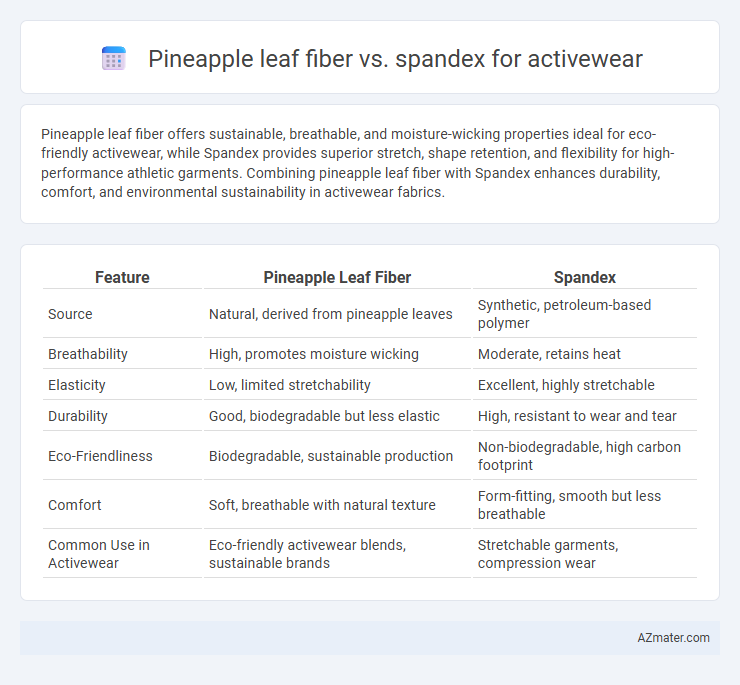Pineapple leaf fiber offers sustainable, breathable, and moisture-wicking properties ideal for eco-friendly activewear, while Spandex provides superior stretch, shape retention, and flexibility for high-performance athletic garments. Combining pineapple leaf fiber with Spandex enhances durability, comfort, and environmental sustainability in activewear fabrics.
Table of Comparison
| Feature | Pineapple Leaf Fiber | Spandex |
|---|---|---|
| Source | Natural, derived from pineapple leaves | Synthetic, petroleum-based polymer |
| Breathability | High, promotes moisture wicking | Moderate, retains heat |
| Elasticity | Low, limited stretchability | Excellent, highly stretchable |
| Durability | Good, biodegradable but less elastic | High, resistant to wear and tear |
| Eco-Friendliness | Biodegradable, sustainable production | Non-biodegradable, high carbon footprint |
| Comfort | Soft, breathable with natural texture | Form-fitting, smooth but less breathable |
| Common Use in Activewear | Eco-friendly activewear blends, sustainable brands | Stretchable garments, compression wear |
Introduction to Pineapple Leaf Fiber and Spandex
Pineapple leaf fiber, derived from the leaves of the pineapple plant, offers a sustainable and biodegradable alternative to conventional textiles, boasting natural breathability and moisture-wicking properties ideal for activewear. Spandex, a synthetic fiber known for its exceptional elasticity and shape retention, provides superior stretch and comfort commonly used in performance garments. Comparing pineapple leaf fiber and spandex highlights a balance between eco-friendly natural materials and high-performance synthetic fabrics in activewear design.
Fiber Origins and Production Processes
Pineapple leaf fiber originates from the leaves of the pineapple plant, harvested as a natural byproduct of pineapple farming, and undergoes a mechanical extraction process followed by cleaning and drying to produce sustainable, biodegradable fibers. Spandex, a synthetic fiber derived from polyurethane polymer, is created through a complex chemical process involving the polyaddition of diisocyanates and polyols, resulting in a highly elastic material specifically engineered for stretch and recovery. The production of pineapple leaf fiber emphasizes eco-friendly practices and renewable resources, while spandex manufacturing relies on petrochemicals and energy-intensive techniques to achieve its characteristic durability and stretchability.
Sustainability and Environmental Impact
Pineapple leaf fiber (Pina) offers a biodegradable and renewable alternative to Spandex, significantly reducing microplastic pollution in activewear. Its cultivation requires minimal water and pesticides, enhancing soil health compared to the synthetic and petroleum-based production of Spandex. Choosing pineapple leaf fiber supports circular fashion initiatives by promoting eco-friendly materials with lower carbon footprints and improved end-of-life decomposability.
Breathability and Moisture Management
Pineapple leaf fiber offers superior breathability compared to spandex, allowing better air circulation and moisture evaporation, which keeps the skin dry during intense workouts. Unlike spandex, pineapple leaf fiber naturally wicks moisture away from the body, reducing sweat accumulation and enhancing comfort. Its eco-friendly properties combined with effective moisture management make it an increasingly popular choice for sustainable activewear fabrics.
Durability and Wear Performance
Pineapple leaf fiber, a natural and sustainable textile, offers excellent durability due to its high tensile strength and resistance to wear and tear, making it ideal for activewear that endures rigorous movement. In contrast, spandex provides superior elasticity and stretch recovery, enhancing wear performance by allowing garments to maintain shape and flexibility during intense physical activity. While pineapple leaf fiber excels in providing eco-friendly toughness, spandex dominates in comfort and fit retention, often leading to blends that optimize durability and stretch for activewear applications.
Comfort and Flexibility in Activewear
Pineapple leaf fiber offers natural breathability and moisture-wicking properties, making it a comfortable choice for activewear, while its lightweight texture enhances airflow and reduces overheating during workouts. Spandex provides exceptional elasticity and stretch, allowing for superior flexibility and freedom of movement critical for dynamic exercises and high-intensity training. Combining pineapple leaf fiber with spandex blends moisture management with stretchability, optimizing both comfort and flexibility in performance apparel.
Weight and Fabric Feel Comparison
Pineapple leaf fiber is significantly lighter than spandex, offering a breathable and natural texture ideal for sustainable activewear. Spandex excels in stretchability and smoothness, providing a snug, skin-like fabric feel that enhances flexibility and movement. While pineapple leaf fiber delivers eco-friendly moisture-wicking properties, spandex dominates in elasticity and softness for high-performance workout gear.
Cost and Market Availability
Pineapple leaf fiber offers an eco-friendly alternative to spandex, with lower material costs but limited large-scale market availability due to less established supply chains. Spandex remains highly cost-effective in mass production, widely accessible in global markets, and dominant in activewear for its superior stretch and durability. Brands focusing on sustainability increasingly explore pineapple leaf fiber despite current price variability and niche market presence.
Innovations and Blended Fabric Options
Pineapple leaf fiber, known for its sustainability and natural breathability, is increasingly blended with spandex to enhance stretch and durability in activewear fabrics. This innovative combination leverages the eco-friendly properties of pineapple leaf fiber with the elasticity of spandex, resulting in moisture-wicking, lightweight, and flexible garments ideal for high-performance activities. Emerging textile technologies focus on optimizing the fiber blend ratios to improve comfort, resilience, and biodegradability, positioning pineapple leaf fiber-spandex fabrics as a cutting-edge option in sustainable activewear.
Future Trends in Sustainable Activewear
Pineapple leaf fiber offers a sustainable alternative to Spandex with its biodegradable properties and minimal environmental impact, making it a promising material for future activewear. Innovations in pineapple fiber processing are enhancing fabric durability and stretchability, addressing traditional limitations compared to synthetic fibers like Spandex. As consumer demand grows for eco-friendly and high-performance activewear, pineapple leaf fiber is expected to gain traction, driving advancements in sustainable textile technology.

Infographic: Pineapple leaf fiber vs Spandex for Activewear
 azmater.com
azmater.com